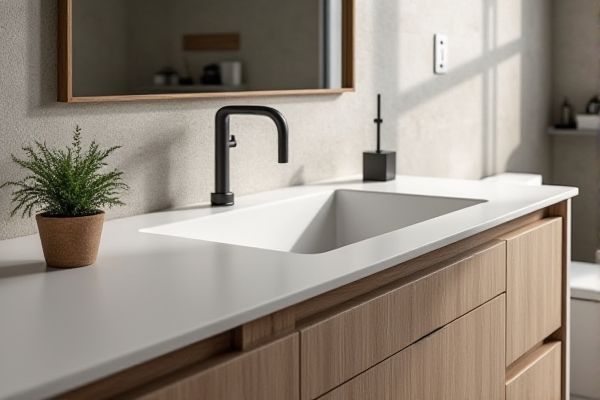
Choosing between an integrated sink and a separate basin affects both the aesthetics and functionality of your kitchen or bathroom space, with integrated sinks offering a seamless, modern look and easier cleaning, while separate basins provide more design variety and flexibility. Explore the advantages and considerations of each option to find the perfect fit for your needs in the rest of this article.
Table of Comparison
| Feature | Integrated Sink | Separate Basin |
|---|---|---|
| Design | Seamless countertop and sink combination | Sink installed independently from countertop |
| Installation | Easier, fewer joints to seal | Requires cutout and mounting hardware |
| Maintenance | Simple cleaning, no grout lines | Edges may collect grime, needs regular cleaning |
| Durability | Less prone to leaks around edges | Potential for water damage at basin gap |
| Cost | Generally higher due to custom fabrication | Often more affordable and replaceable |
| Customization | Limited to countertop material and shape | Wide variety of styles and sizes available |
| Aesthetic | Sleek, modern, minimalist look | Traditional to contemporary styles |
Introduction to Integrated Sinks and Separate Basins
Integrated sinks feature a seamless design where the basin and countertop form a single, continuous surface, enhancing hygiene and ease of cleaning. Separate basins are individual units installed within or on top of a countertop, offering flexibility in style and replacement without altering the entire surface. Your choice depends on aesthetic preferences, maintenance considerations, and space requirements.
Key Differences Between Integrated Sinks and Separate Basins
Integrated sinks combine the basin and countertop into a single seamless unit, offering easy cleaning and a sleek, modern look. Separate basins are individual sinks installed into or on top of countertops, providing more design flexibility and easier replacement options. Your choice impacts durability, installation complexity, and maintenance needs.
Aesthetic Appeal and Design Considerations
Integrated sinks create a seamless, modern aesthetic by merging the basin and countertop material, enhancing visual cohesion in kitchen or bathroom designs. Separate basins offer versatility in styles, shapes, and materials, allowing for personalized design elements that can complement various decor themes. Consider design goals, maintenance, and countertop material compatibility when choosing between integrated sinks and separate basins for optimal aesthetic appeal.
Space Efficiency and Installation Requirements
Integrated sinks offer superior space efficiency by combining the countertop and sink into a seamless unit, reducing gaps and maximizing countertop area. Installation requires precise measurements and professional fitting to ensure watertight seals and proper alignment, often demanding more time and expertise. Separate basins provide flexibility in placement and easier replacement but typically occupy more counter space and involve simpler installation with standard plumbing connections.
Cleaning and Maintenance Comparison
Integrated sinks offer a seamless surface with fewer crevices, making cleaning faster and reducing the buildup of grime and mold compared to separate basins. Separate basins often have joints and edges where dirt accumulates, requiring more detailed scrubbing and maintenance to prevent stains and mildew. Materials such as quartz or solid surface used in integrated sinks enhance stain resistance and simplify upkeep over traditional ceramic or porcelain basins.
Durability and Material Options
Integrated sinks are typically made from durable materials like solid surface, quartz, or acrylic that offer seamless construction, reducing the risk of leaks and simplifying maintenance. Separate basins often come in a wider variety of materials, including stainless steel, porcelain, and ceramic, which can provide enhanced resistance to heat and stains but may require periodic sealing. Both options offer durable performance, but integrated sinks excel in durability through monolithic design, while separate basins allow for more diverse material choices suited to specific kitchen or bathroom needs.
Cost Analysis: Upfront and Long-term Expenses
Integrated sinks generally offer lower upfront costs due to streamlined manufacturing and installation processes, reducing labor expenses. Separate basins may have higher initial costs because they involve distinct fixtures and more complex plumbing setups. Over the long term, integrated sinks can minimize maintenance expenses by eliminating seams where grime accumulates, whereas separate basins might require more frequent repairs or sealant replacements.
Suitability for Different Kitchen and Bathroom Styles
Integrated sinks offer a seamless and modern look that suits contemporary and minimalist kitchen or bathroom designs, providing easy cleaning and a streamlined appearance. Separate basins are versatile, fitting traditional, rustic, or transitional styles, and allow for more customization in materials and installation configurations. Your choice depends on whether you prioritize a cohesive aesthetic with integrated sinks or flexible design options with separate basins.
Pros and Cons Summary of Each Option
Integrated sinks offer seamless design and easier cleaning since the basin and countertop are one continuous piece, reducing dirt buildup and water leakage. Separate basins provide greater flexibility in style and materials, allowing you to customize your sink independently from your countertop, but may require more maintenance due to joints. Choosing between integrated and separate sinks depends on your priorities for aesthetics, durability, and ease of upkeep.
Which Sink Type is Best for Your Needs?
Integrated sinks offer a seamless design that combines the basin and countertop, making cleaning easier and providing a modern aesthetic ideal for contemporary kitchens. Separate basins provide flexibility with varied materials, styles, and sizes, allowing customization to suit specific tasks and preferences in your kitchen workflow. Your choice depends on whether you prioritize easy maintenance and sleek appearance or versatility and individual component replacement.
 homyna.com
homyna.com